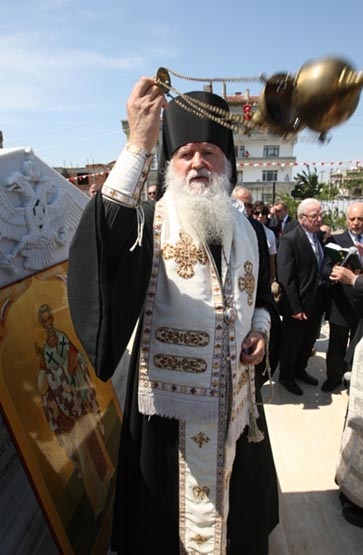Nicole finished her volunteer work at the English school mid month. The owner of the school invited us in for tea and cake and to say good bye this week. She wanted some insight into our plans for the fall. If Nicole and I wanted full time jobs, I think we could easily have them. Cam's work was a little bit busier with the annual holiday lead up panic from his bosses. We spent a 4 day weekend across the Marmara at Assos. (See photos below) to celebrate my birthday. Cam located the Russian monument in Gelibolu after two years of looking. (more photos) We spent a day with a Canadian couple, friends of company management,who were on vacation in Turkey. They have lived in a variety of countries from Borneo to Colombia, so they had interesting stories to tell. Our experiences of life away from home have been very similar. Nicole and Sam wrapped up their school courses this month and as the month closes we're all getting ready to pack for our annual leave.
White Russians fled Russian between 1917 and 1920 as a result of the revolution. Some came to Gelibolu, Turkey. There is a fascinating collection of photographs of Gelibolu and the Russians refugees as well as long lists of Russians at this site.
The monument is fenced and the grounds are only open to the public some days. The monument is located south of Kipa on a dead end residential street. Put the latitude and longitude into your GPS and you should be able to drive right to it! (N40.414733 E26.662709)
For my birthday this year, Cam took us to Assos/Behramkale for a few days. It was lovely and warm and the scenery was spectacular.
Assos is the name of the ancient pre-Roman town that included a hill top Athena Temple, Roman theatre, agora and harbour. There are also some ruined Byzantine era churches on the hillside. There is limited access to the sites and to be honest not a great deal to see - except the amazing feats of engineering and rock moving!
Arches on either side of the theatre used to lead to the seats, but are now blocked off. Sam's grown a little but this still isn't very spacious.
This port at Assos, down the hill from the theatre, was the one Paul, the Apostle. used to get a boat to Lesvos (Acts 20). Lesvos or Lesbos is a large Greek island. There is limited ferry service from Turkey, but you can get ferries to the island from mainland Greece.
Assos Harbour
I went for a closer look and discovered they weren't empty!
They were full of sheep trying to stay cool.
We stayed cool in the hotel's pool.
A village oven.
Asso - Athena Temple
Cistern near the temple.
The Temple of Appolon Smintheus (Lord of the Mice) is located beside the town of Gulpinar.(Gulpinar is about 30 minutes from Behramkale) As usual signs are rare, but we only had to ask for directions once. The site is enormous and has signs in English and Turkish The ruins include the temple, (Photos above and below), a bath house and a section of Roman road. http://www.timeout.com/travel/features/1391/troy-story-r-spending-and-finding-a-penny-inside-apollos-temple
We had a bite of lunch at the "cafe" next door. They had running water and toilets! The fellow who served us followed us to the car to ask where we were from and to compliment Cam on his Turkish.
Cam drove a very scary narrow winding coastal road to get us to Babakale. The town is located on a cape which is the most westerly point on the continent of Asia. Its refurbished clifftop castle overlooks the Aegean.
We just about had the place to ourselves until a bunch of rowdy school boys arrived with their two "minders". The boys jumped from spot to spot and raced around the ramparts in herds. Like most Turkish sites, there are no "safety measures" (guardrails, fences etc), just a sheer drop of some tens of feet to rocky ground below.
The view from the ramparts.
The rest of these photos I took while I waiting for Nicole to come from the English school. There is an area in the centre of the Gelibolu where there are no cars allowed. (but watch out for garbage trucks, scooters, motorcycles, delivery vans and occasionally truck mounted cranes.)
On the left, the video store. On the right the candy store - with an ice cream cooler out front. None of these stores have central heating and most have no a/c. If the door is ajar the shop is open for business. It's not unusual to go into a shop and find no one else there. The clerk will follow you through the door a few minutes later, because they've been lounging outside or chatting with friends nearby.
Women dress in a variety of ways. We occasionally see women in burqas with niqabs, but more often women wear head scarves and long coats. In our area, I think most women dress without demonstrating any sort of religious affiliation.
There are lots of benches in the area. The flags are for various political parties. There is a national election in Turkey June 7.




























 In
2008, at the initiative of private individuals in Russia and with the
help of the Russian Government, the monument was restored in its
original form and ceremoniously unveiled on May 17. A plot of land was
dedicated for it surrounded by a fence, and a memorial museum
containing photographs, pictures and a krasniy ugol ["beautiful corner" with icons].
In
2008, at the initiative of private individuals in Russia and with the
help of the Russian Government, the monument was restored in its
original form and ceremoniously unveiled on May 17. A plot of land was
dedicated for it surrounded by a fence, and a memorial museum
containing photographs, pictures and a krasniy ugol ["beautiful corner" with icons].


